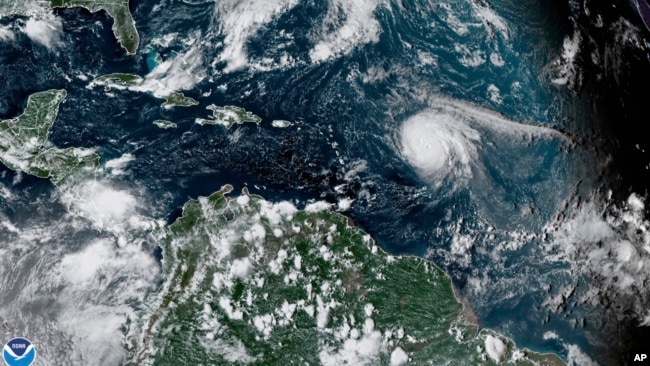■
これから梅雨が始まり、台風シーズンへと突入します!!
でも、二酸化炭素排出を減らし、空気がきれいになったことが、太陽光を増加させ、水温を上昇させるなんて、なんと皮肉なことでしょう!!????
世界で被害が出ませんように。。。。
今日もVOAで英語を学びましょう!!
米政府機関、ハリケーンシーズン到来を予測(和訳)
US Agency Predicts Busy Hurricane Season
May 25, 2022
米国政府系気象機関のリーダーが、今夏の大西洋のハリケーンシーズンは記録的なものになるとの見通しを示しました。
リック・スピンラッド氏は、NOAA(米国海洋大気庁)の管理者です。同氏はAP通信に対し、大西洋の夏季には14から21の大型暴風雨が発生するだろう、と語りました。そのうちの約半数はハリケーンと呼ばれる強力な暴風雨になり、そのうち3〜6個は、風速200キロの大型ハリケーンになります。
また、被害をもたらす暴風雨の発生数は、長期的に見ると変化しています。30年間で、大きな暴風雨の数は約14個。しかし、2020年は30個、昨年は21個でした。
ハリケーンの強さは、そのカテゴリーで示されます。カテゴリー5の嵐は、計測された風速が最も高いものです。スピンラッド氏によると、過去5年間で、米国の陸地に到達したカテゴリー4または5の嵐の数は、それ以前の50年間のそうした嵐のすべてよりも多かったと言います。
彼は、今年は過去と”似たような”ものになるとし、「この見通しの下で計画を立てられないなら、失敗を計画することになるだろう。」と警告しています。
同氏は、通常暴風雨の影響を受ける沿岸部に家や土地を所有している人は、財産を守る必要があると述べています。
マシュー・ローゼンクランズ氏はNOAAのために暴風雨を予測します。大型のハリケーンを発生させる要因は今年すべて揃っていると彼は言います。西アフリカの大雨季もその一つです。世界中の天候に影響を与えるラニーニャと呼ばれる太平洋の冷却パターンも予測要因の一つです。また、気候変動による海水温の上昇もそのひとつです。
NOAAとは関係のない他の気象専門家達も、今年は被害をもたらす嵐の数が多くなるだろうという意見に同意しています。ラニーニャ現象がハリケーンの強さを弱める風の一種を減少させるからだ、と彼らは言います。世界の国々が公害を減らすにつれて、空気はきれいになっているとも言っています。これが太陽光を増加させ、水温を上昇させます。
ディーン・クリスウェル氏はFEMA(連邦緊急事態管理庁)の長官です。この機関は、災害後の人々を支援する機関です。
ニューヨークで行われた記者会見で、「私たちは、これらの嵐がより頻繁に起こっているのを見ています。」と彼女は話します。「「それらは、長続きするようになった 」と。
クリスウェル氏は、気候変動による嵐の数の変化は "劇的 "であると述べています。
NOAAによると、2021年にハリケーン・アイダが米国北東部の多くの都市を浸水させ、13人が死亡、ニューヨークでは地下の住宅に住んでいた11人が洪水のため死亡したと言います。今年は、ニューヨークの多くの都市で停電や洪水を引き起こした大型暴風雨サンディから10年目でもあります。
NOAAは、今年のストームシーズンは65%の確率で "平年以上 "になると発表しています。
フィル・クロツバッハ氏はコロラド州立大学でハリケーンを研究しています。彼は、嵐の強さを示すACEが6年連続で高いのは記録的であり、"本当に珍しい "と言っています。
他の10の気象チームもNOAAに同意しています。政府、大学、民間の気象会社からなるグループです。彼らの予測の平均は、20の大きな嵐と8つのハリケーンがあることを示唆しています。そのうち4つのハリケーンが大きなものになると予想されています。
NOAAは、太平洋は涼しいラニーニャ現象の影響で、より静かになると予測しています。
大西洋のハリケーン・シーズンは6月1日に始まります。
US Agency Predicts Busy Hurricane Season
A leader of the U.S. government-run weather agency said he expects a record-setting hurricane season this summer for the Atlantic Ocean.
Rick Spinrad is the administrator for NOAA, the National Oceanic and Atmospheric Administration. He told the Associated Press that the summer season in the Atlantic will produce from 14 to 21 large storms. About half of them will become the powerful storms known as hurricanes. Three to six of them will turn into major hurricanes with winds measuring about 200 kilometers per hour.
The number of damaging storms changes over long periods of time. Over 30 years, the number of large storms was about 14. But in 2020, there were 30 and last year there were 21.
The strength of a hurricane is shown by its category. Category 5 storms have the highest measured wind speeds. Spinrad said, in the past five years, the number of Category 4 or 5 storms that reached land in the United States was more than all such storms in the 50 years before that.
He said this year will be “similar” to past years and warned “if you fail to plan around this outlook, you’re planning to fail.”
He said people who own homes or land in the coastal areas usually affected by storms need to protect their property.
Matthew Rosencrans predicts storms for NOAA. He said all of the things that go into producing big hurricanes are present this year. That includes a heavy rainy season in West Africa. A cooling pattern in the Pacific Ocean known as La Nina that affects weather around the world is another predictor. And warmer ocean temperatures caused by climate change are another.
Other weather experts not associated with NOAA agreed that there will be a higher number of damaging storms this year. They said the La Nina weather event reduces a kind of wind that can lower the strength of hurricanes. As countries around the world reduce pollution, the air has become cleaner, they said. This increases sunlight that makes water temperature rise.
Deanne Criswell is director of FEMA, the Federal Emergency Management Agency. The agency helps people after disasters.
“We’re seeing these storms happen more frequently,” she said at a news event in New York City. “They’re lasting longer.”
Criswell said the change in the number of storms that come from climate change is “dramatic.”
NOAA said 13 people died in 2021 when Hurricane Ida flooded many cities in the northeastern U.S. Eleven people in New York City who lived in below-ground housing died because of the floods. This year is also the 10-year anniversary of Sandy, a large storm that caused a loss of power and flooding in much of New York City.
NOAA said there is a 65 percent chance that this year’s storm season will be “above normal.”
Phil Klotzbach researches hurricanes at Colorado State University. He said six straight years with a high ACE, a measure of storm strength, is a record, and “really strange.”
Ten other weather teams agree with NOAA. The groups come from the government, universities and private weather companies. The average of their predictions suggests there will be 20 big storms and eight hurricanes. Four of those hurricanes are expected to be major ones.
NOAA predicts the Pacific Ocean will be quieter because of the influence of cool La Nina conditions.
Atlantic hurricane season starts on June 1.
Words in This Story
category – n. a group of things that are similar
pattern– n. something that happens in a repeated way
frequent- adj. happening often
dramatic- adj. sudden, extreme, or claiming a lot of attention
